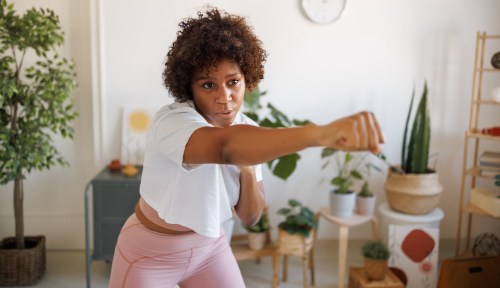Our editors independently select these products. Making a purchase through our links may earn Well+Good a commission
Billy Blanks’s Tae Bo Videos Were My Go-To Workout as a Teenager. They’re Still a Fun, High-Energy Release Today
Billy Blanks's tae bo videos were my go-to workout as a teenager. Find out what it's like to return to them today.

Several weeks ago, I attended a self-defense class. Our instructor stood in the middle of the room to demonstrate poses for cautious contact. We were shown how to position our torso, how to hold our hands. The stance was meant to help us easily switch into a squatting position where we could use the power of our legs to fight off perpetrators.
“Where are women not very strong?” the instructor asked us.
“Our upper bodies,” one woman offered.
“And where does our strength lie?”
Our legs, we all answered unanimously. She then taught us a series of punches, kicks, and jabs.
The moves felt familiar. As a teenager at the turn of the millennium, I’d done Billy Blanks’s Tae Bo workouts religiously. At the time, I wasn’t that interested in self-defense. I was drawn to the video’s back jacket promise that I would burn 800 calories per hour. Turns out, though, Tae Bo had taught me something other than just how to keep myself small.
In adolescence, I completed the Advanced Tae Bo workout video at least a thousand times. Though I dabbled with other exercise tapes, there was just something about Blanks’s program that had a hold on me. The marketing promised that I’d become strong enough to kick a man’s ass—and look great while doing it.
In adulthood, I mostly abandoned Blanks’s workouts. I’d worn them out and had moved on to workouts that were outdoors or communal. It wasn’t until a recent rainy day that I tried the video out again with my two young, stir-crazy sons. They were always trying to kick and punch each other, anyway. I figured I should give them a context to channel that fury.
They were intrigued, at first, and participatory. About 15 minutes into the program, they walked away.
I, however, continued with the tape. The hour-long video was divided into 30-minute halves: the first for cardio, the latter for “sculpting” and stretch. Despite the number of punches and jabs, the arms actually received very little attention in the workout; the focus was on lower body and core—right where, as my self-defense instructor had pointed out, women hold their power.
Blanks stood in the center of a red-carpeted studio with his class behind him. Though there was some ethnic diversity, the bodies looked mostly the same: fit and on the more youthful end of middle-aged. The most conventionally attractive (or thin) women were placed closest to Blanks. If I squinted, I could just make out the vague figures of two men way off in the back.
Though far-removed from adolescence, I still had most of the workout memorized. I’d forgotten, though, how often Blanks repetitively counts to eight. I believe the intention was to motivate us to get through each set. I mostly found it grating.
Rewatching the video as an adult who has participated in a number of fitness classes, I also noticed that he gives very little guidance regarding position or alignment. Where exactly should I be placing my hands? Should I be engaging my core? (Probably, yes.)
No one talks during the workout except for Blanks—but the participants are not silent. You can often hear them screaming, animal cries that reminded me of the sounds I made during labor. They typically made these noises at the end of a set of squats.
The name Tae Bo is a mash-up of taekwondo (a Korean martial art) and boxing. Though the logo co-opts the Chinese symbol for yin and yang, there is little else mentioned in the tape that invokes or honors Asian cultures.
Blanks makes two vague spiritual references, encouraging viewers to draw strength from their higher power as they work their glutes. But then he pivots back to continue his repetitive counting.
Perhaps the most jarring part of the workout was how few modifications Blanks offers for different skill sets and abilities. Near the end of the tape, he does say, “If this starts to bother your back, go down on your elbows.” But then he immediately chides one of the students behind him for taking this modification. “Dionne,” he yells. “Get up. I ain’t gonna let you give up!”
One thing I do appreciate: Despite Tae Bo’s advertising weight loss as the main draw to the workout, fortunately, Blanks talks about this little, if at all. At one point, he vaguely references having a “swimsuit body,” but then he tells the participants to focus on the workout, to not become distracted by the goal.
And it’s not hard to focus on the workout. After all, it’s pretty fun. It feels good to have permission to kick and punch the air. I see why I was so devoted to the workout as a teenager: It’s a great, socially-appropriate way to get out adolescent (or adult) aggression.
Though Tae Bo is certainly a product of its time (if only we had been talking about diet culture in the 90s), the workout remains a fun challenge, and a campy relic. You just have to watch your own form and listen to your body to make sure you don’t get injured. Still it’s a video I will certainly stream again on a rainy day whenever the kids just won’t stop fighting each other.
Try a HIIT boxing workout to get a taste of that sweet release:
Sign Up for Our Daily Newsletter
Get all the latest in wellness, trends, food, fitness, beauty, and more delivered right to your inbox.
Got it, you've been added to our email list.










